Workshop: “Punishment as a Crime? Interdisciplinary Perspectives
advertisement
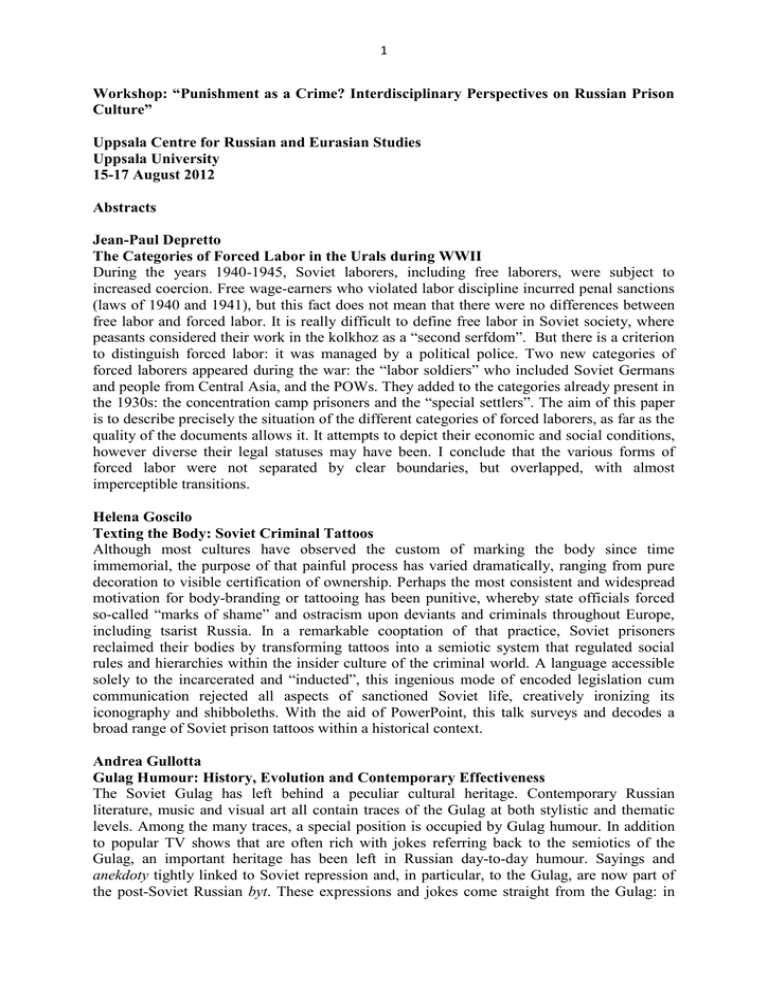
1 Workshop: “Punishment as a Crime? Interdisciplinary Perspectives on Russian Prison Culture” Uppsala Centre for Russian and Eurasian Studies Uppsala University 15-17 August 2012 Abstracts Jean-Paul Depretto The Categories of Forced Labor in the Urals during WWII During the years 1940-1945, Soviet laborers, including free laborers, were subject to increased coercion. Free wage-earners who violated labor discipline incurred penal sanctions (laws of 1940 and 1941), but this fact does not mean that there were no differences between free labor and forced labor. It is really difficult to define free labor in Soviet society, where peasants considered their work in the kolkhoz as a “second serfdom”. But there is a criterion to distinguish forced labor: it was managed by a political police. Two new categories of forced laborers appeared during the war: the “labor soldiers” who included Soviet Germans and people from Central Asia, and the POWs. They added to the categories already present in the 1930s: the concentration camp prisoners and the “special settlers”. The aim of this paper is to describe precisely the situation of the different categories of forced laborers, as far as the quality of the documents allows it. It attempts to depict their economic and social conditions, however diverse their legal statuses may have been. I conclude that the various forms of forced labor were not separated by clear boundaries, but overlapped, with almost imperceptible transitions. Helena Goscilo Texting the Body: Soviet Criminal Tattoos Although most cultures have observed the custom of marking the body since time immemorial, the purpose of that painful process has varied dramatically, ranging from pure decoration to visible certification of ownership. Perhaps the most consistent and widespread motivation for body-branding or tattooing has been punitive, whereby state officials forced so-called “marks of shame” and ostracism upon deviants and criminals throughout Europe, including tsarist Russia. In a remarkable cooptation of that practice, Soviet prisoners reclaimed their bodies by transforming tattoos into a semiotic system that regulated social rules and hierarchies within the insider culture of the criminal world. A language accessible solely to the incarcerated and “inducted”, this ingenious mode of encoded legislation cum communication rejected all aspects of sanctioned Soviet life, creatively ironizing its iconography and shibboleths. With the aid of PowerPoint, this talk surveys and decodes a broad range of Soviet prison tattoos within a historical context. Andrea Gullotta Gulag Humour: History, Evolution and Contemporary Effectiveness The Soviet Gulag has left behind a peculiar cultural heritage. Contemporary Russian literature, music and visual art all contain traces of the Gulag at both stylistic and thematic levels. Among the many traces, a special position is occupied by Gulag humour. In addition to popular TV shows that are often rich with jokes referring back to the semiotics of the Gulag, an important heritage has been left in Russian day-to-day humour. Sayings and anekdoty tightly linked to Soviet repression and, in particular, to the Gulag, are now part of the post-Soviet Russian byt. These expressions and jokes come straight from the Gulag: in 2 fact, humour came out spontaneously in the camps from the very beginning of Soviet history. The prisoners composed songs and created jokes, some of which became an important part of lagernaya kultura, while many words, generated in a humorous context, became part of the lagernyi zhargon. One of the most interesting aspects of Gulag humor is its universal character, i.e. unlike most of the products of Gulag culture, it was composed by prisoners coming from many different backgrounds. For this reason, it sometimes constituted a link between different social and ethnic groups of prisoners. This paper provides an analysis of Gulag humour, highlighting some of its most important specimens. A brief overview of Gulag humour will be given, while a few main features will be analyzed, such as the importance of semiotic proficiency, the differences between the intellectual and the shpana humour, the evolution of Gulag humour following the evolution of the Gulag system, etc. This paper also aims at highlighting the connection between Soviet culture and contemporary Russian culture, in an attempt to find common semiotic ground that guarantees effectiveness to this peculiar type of humor in both past and present cultures. Larisa Kangaspuro Пенитенциарная культура дореволюционной России Тюрьма и её обитатели образуют особый, крайне своеобразный мир с оригинальным укладом жизни и нетипичными бытовыми особенностями. Тюремный опыт индивида напрямую зависит от пенитенциарной культуры в обществе, которая складывается из законодательного регулирования и практики его применения в государстве, так же как и из национальных особенностей социума. Почему понятие «русская тюрьма» стало нарицательным? В середине 19 века тюремный вопрос был модным и в литературе, и в законодательных собраниях. Организовывались специальные местные и международные тюремные съезды, в университетах открывались кафедры тюрьмоведения, правительства не останавливались перед громадными расходами для проведения реформы тюремного дела. Россия старалась идти в ногу с мировыми пенитенциарными достижениями, но эффективность их воплощения в масштабах страны была сомнительной. Однако не только каторга и ссылка тормозили это развитие. Историческое развитие империи отразилось на применении лишения свободы к политическим заключенным, и в конечном счёте, привело к значительному увеличению заключённых в русских тюрьмах после событий 1905 г. Несмотря на все предпринимаемые царским правительством попытки, западные модели не смогли прижиться на русской почве. В России, с её исторически сложившейся тягой к благотворительности и православным милосердием, было больше частной инициативы и активности, которую консервативное правительство долгое время отказывалось поддерживать на государственном уровне. В выступлении обобщаются причины, приведшие к индивидуальному пути развития российской пенитенциарной культуры. На основе мемуарной литературы анализируются особенности положения «политических» среди «уголовников». Особое внимание уделяется дореволюционной историографии проблемы. Elena Katz and Judith Pallot “My path lies drear and wild…”: A Prisoner Wife in Russia This paper explores representations of the experiences of prisoners’ women relatives in Russia past and present. We investigate how these women, while not formally part of the penal system, are drawn into it as “quasi-prisoners” and are forced to submit to its disciplinary control. The annals of Russian national history glorify the handful of wives who voluntarily chose to share the “vicissitudes of fate” in Siberian exile with their husbands punished for the anti-monarchist uprising in December 1825. Since then, Russian cultural 3 mythology has promoted a powerful, iconoclastic image of the “Decembrist wife” as the epitome of marital love, devotion and personal sacrifice. On the basis of various historic, literary, documentary and internet sources, and twenty five interviews with current Russian prisoners’ women relatives, we examine the formation, articulation and lasting vitality of the “Decembrist wife” discourse in Russia. Martin Kragh Free and Non-free Labour during Stalinism: An Overview The Soviet regime applied different levels of coercive measures in order to control its population. Whilst the forced labour camp system – known under its acronym the Gulag – remains the most visible expression of repression and non-free labour under Stalin, the regime applied also other measures against its population. Coercive legislation on work, food supply and housing was used in order to control and contain workers in civilian industry, in effect blurring the distinction between “free” and “non-free” labour. Under Stalin, such measures were taken to their highest levels. In quantitative terms, these measures also affected a potentially much larger segment of individuals, as the Gulag system never represented more than a few percent of the total population. In my paper, I present evidence from archival research on the various forms of non-free labour which co-existed in the Soviet Union, where the Gulag was merely the end-point of a series of repressive measures. С.В.Любичанковский Развитие пенитенциарной системы российской провинции в позднеимперский период (на материалах Оренбургского края) Внедрение в законодательство и практику принципов гуманизации наказания, его увязки с целями исправления составили основное содержание новой тюремной политики. Ее осуществление в Оренбургской губернии сопровождалось заметными региональными особенностями. Стремление к централизации привело к решению оренбургских властей создать в губернии уже с 1883 г. орган с соответствующими функциями. Это решение почти на 10 лет опередило общеимперские процессы в данной сфере. В ходе реализации реформы в тюремной системе региона постоянно менялся количественный и качественный состав заключенных: рост численности; появление устойчивого «женско-детского» контингента; перераспределение контингента заключенных в пользу более тяжких правонарушителей; резкий рост группы пересыльных. Характерными чертами материально-технического состояния тюрем региона являлись теснота помещений, ветхость тюремных зданий, слабая здравоохранительная база. В период реализации реформы в регионе стали реально решаться проблемы улучшения питания (работа по созданию тюремных огородов) и развития хозяйственных работ заключенных. В основе этих успехов лежал принцип личной заинтересованности как заключенных, так и тюремных служащих. Одним из способов «исправления» заключенных в оренбургских тюрьмах являлась религиозная и образовательная деятельность, поставленная под контроль православного тюремного священника. Однако эта деятельность ограничивалась рядом объективных факторов: многоконфессиональный состав заключенных, переполненность тюрем, недостаток финансирования, сложившаяся в Оренбургском крае под влиянием местной каторжной тюрьмы в Илецке прочная «тюремная община» со своими правилами, которые нередко противоречили общепринятым социальным нормам. Официальные показатели эффективности исправительных мероприятий, выражавшиеся в количестве досрочно освобожденных, в исследуемый период росли (с 5 до 8%), но существенного масштаба не приняли. 4 Arnold McMillin Belarusian Prison Poetry In Polish-ruled Western Belarus, before 1939 when it was incorporated into the Soviet Union, many prominent Belarusian poets such as Michaś Mašara (1902-1976), Valancin Taǔłaj (1914-1947) and Maksim Tank (1912-1995) were imprisoned in Vilna for their nationalist convictions, whilst Łarysa Hienijuš (1910-1983), who had emigrated to Czechoslovakia, was forcibly repatriated by the Soviets and served a term in the GULag from 1949 to 1956, where she composed several poems that appeared on her release. Both before the collapse of the Soviet Union and after it, as “the last dictatorship in Europe”, Belarus has produced both prose and poetry written in prison. Of the earlier generation, Siarhiej Novik-Piajun (1906-1994) published Pieśni z-za krataǔ (Songs from behind bars, 1993), just before Łukašenka came to power. A year later in November 1995 the extravagant poet Słavamir Adamovič (b. 1962), wrote a poem in Russian, ‘Ubei prezidenta!’ (Kill the president!), and in the predictably ensuing term in prison wrote Turemny dziońnik (Prison diary, 2001) in prose but with some verse. Most recently, Uładzimir Niaklajeǔ (b. 1946), one of Belarus’ most outstanding poets, stood as a candidate for the country’s presidency in the disputed elections of December 2010. After being beaten up and imprisoned, he has produced some remarkable work from his period under arrest, including a narrative poem, “Turma” (Prison) and a cycle (soon to become a book), dedicated to his wife, Vola (which is also the Belarusian word for freedom), “Listy da Voli” (Letters to Vola, 2011). Inessa Medzhibovskaya “My Cell, My Love”: Prison and the Human Condition Imprisonment, incarceration and other forms of forced confinement are routinely discussed in political theory and the social sciences in terms of Arendt's theory of totalitarianism, Foucauldian biopolitics or Agamben's writings on the state of exception. When they turn to the examination of prison narratives, the humanities eagerly and yet somewhat reductively adopt these same interpretive methodologies and critical angles while having recourse as well to explanatory paradigms of trauma and witnessing offered by Butler, LaCapra, Felman and Sontag, among others. This paper argues that literature in both its fictional and non-fictional varieties has always treated the topic more pluralistically, reiterating almost to the point of ambivalence that confinement is not an exception to, but a constituent part of the human condition. It goes without saying that no matter how many common places and tropologies can be identified in the situation of confinement as a form of shared experience, it remains an aberration that cannot be undone by the mastery and totality of representation. And yet the persistent need to give literary expression to what is often beyond describing deserves a more disciplined consideration. In an attempt to reevaluate how writing responds to the ordeal of confinement as such, this paper looks into resonances, dissonances and references among texts dealing with confinement across time and place. The critical focus is on closed spaces and the voice-- on the topics and forms in which the isolated voice speaks, and on its relationship with one's body and mind, other bodies and minds, and with the audience. Judith Pallot Geography as Punishment: Continuities in the Spatial Choreography of Penality in 20thand 21st-Century Russia This paper is based on research conducted for an ESRC funded project between 2007 and 2011 in the Russian Federation on the impacts of the geography of punishment on the experiences of imprisonment in post-Soviet Russia. Taking up the theme of the workshop – “punishment as crime?”—I will examine how the “places” and “spaces” of confinement in 5 Russia have been experienced punitively by people drawn into the Russian penal system. The analysis considers how the particular geography of penal institutions subjects prisoners to forms of disciplinary and coercive mobilization that contribute to prisoners’ feelings of isolation and degradation, whether this is in their transportation to penal colonies in peripheral locations or the micro-choreography of their movement at the level of colony itself. It also considers how the “place” of the prison impacts upon prisoners’ experience –not just through distance which disrupts family relationships, but by generating feelings of being “out of place”. It draws on interview and other materials collected during the course of a recent (2006-2010) ESRC-funded project. Prisoners might no longer be subjected to “mosquito punishment” as they were during the time of the Gulag but, as I will argue, the specific geography of penalty inherited from Soviet Russia adds to the Russian prisoner’s pains. Andrei Rogatchevski A Cell of One’s Own: Modern Incarceration Under Western and Eastern Eyes This is a comparative analysis of the prison autofiction by the author, businessman and politician Jeffrey Archer (who served a sentence for perjury in various British jails in 200102) and Eduard Limonov (who was convicted for gun running in 2001 and released in 2003, having been at Lefortovo, Butyrka, Saratov and a number of other prisons and penal colonies). The paper deals with the “writer in jail” topos and attempts to find a balance between the general and the specific in prison conditions and their influences on an individual psyche. Valentina Shatalina Морально-этические представления через призму тюремной темы в российских киносериалах На фоне политических событий в России тема закона, наказания, правового нигилизма, морали является темой, затрагивающей жизнь каждого человека, пытающегося осмыслить непрошедшее историческое время. Наш доклад посвящен анализу трех российских сериалов – “Зона”, “Тюрьма особого назначения” и ”Острог” – показанных в прайм тайм одним из ведущих каналов российского телевидения (НТВ), в период между 2006 и 2012 годом, и успешно распространяемых в формате on-line и DVD. Экспериментальное психологическое исследование в тюрьме является фактически невозможным событием (cp. Ф. Зимбардо, С. Аш, С. Милгрем), и телесериал мы рассматриваем как проективный материал, дающий возможность анализа типичных проявлений морали и тюремной культуры. Полагая, что западный и российский подходы к моральным ценностям очень похожи (в обоих культурах украсть плохо, помочь бедному хорошо, победить – прекрасно), следует отметить, что существует разница между этической системой и системой ценностей. Каждый элемент системы ценностей соответствует конкретному коду добра и зла и может касаться любого явления. В познавательной системе личности имеются правила перехода между элементами ценностей и системой ценностей. Мы используем подход Владимира Лефевра, согласно которому выделяются только два таких правила: первое, что соединение добра и зла есть зло, а второе - что добро. Эти правила и предопределяют этические системы. В докладе показаны результаты исследования представленных в сериалах этических систем, а также возможные эффекты, в том числе востребованные в мире интерактивного потребления (через гаджеты) и оказывающие влияние на воспитание детей и взрослых. Igor Sutyagin 6 Russian Prison Culture: A Participant-Observer’s View Russian prison culture is often mystified as something absolutely unique and difficult to understand. At the same time, it is both interesting and instructive to look at the needs which have shaped this specific sub-culture – both educational and “social” ones within the criminal sub-society. An attempt to do so constitutes one part of my presentation. It is also quite clear that Russian prison culture is just one phenomenon within the framework of a wider Russian social culture. Therefore, a brief overview of the influence of the social situation upon inmates is useful for a better understanding of the current state of Russian prison culture. The myth of the so-called “Black” and “Red” colonies will be discussed, along with the deforming influence of the prison environment upon inmates as citizens of the state. Dariusz Tolczyk To Tell or Not to Tell: Western Responses to Stalin's Crimes The crimes of Nazism and Communism, though similar in many respects, have been addressed in the West in strikingly dissimilar ways. While the former have been widely recognized and reflected upon, the latter have been largely forgotten. This is because, for the most part, remembering Nazi atrocities invites morally uplifting recollections of the Western powers' victory over Hitler and his ideology, while remembering Soviet crimes inevitably revokes shameful memories of Western blindness and indifference to Lenin's and Stalin's atrocities. This paper analyzes how this blindness and indifference were shaped. It discusses objective factors such as the lack of direct evidence of Soviet crimes in the West and the necessity of relying on verbal testimonies; the unprecedented – and therefore hard-to-believe – nature of Bolshevik atrocities; and the effectiveness of Soviet propaganda. It also addresses subjective sources of Western dismissals of Soviet crimes: the readiness of many Western public-opinion makers to believe at all costs in the Marxist-Leninist utopia; the supremacy of this belief over a critical analysis of facts; and, finally, the willingness of many in political and business establishments to conceal Soviet crimes for the sake of good relations with Stalin. Sarah J. Young Representing Prison Life: Criminal Creativity in the Imperial and Soviet Eras This paper explores how the position and representation of the criminal world, an area frequently posited as indicating a radical break between the pre-revolutionary and Soviet penal systems, in fact becomes a source of continuities, through the recurring theme of the criminal as poet, verbal artist and literary connoisseur. Two distinct strands are identified in the development of the idea of criminal creativity: the verbal antics of Dostoevskii's peasantconvicts are connected to the construction of Siniavskii-Terts's Golos iz khora, which uses the prisoners' utterances to contextalize his own meditations on artistic subjects, while Doroshevich's exploration of the morality of “poet-murderers” on Sakhalin prefigures the violence of Shalamov’s depiction of the criminal world in Kolyma, in which creativity engenders destruction. Comparing these opposing approaches, the paper examines the ways in which in both cases, the theme not only becomes the basis for reflection on wider questions surrounding relationships between criminals, political convicts, and camp/prison authorities, and a commentary on conditions and the impact of the system upon its inhabitants, but also relates to the problem of representing the experience of incarceration. А.В. Захарченко Хозяйственные злоупотребления и имитация труда как форма адаптации в лагерном социуме (на примере Безымянлага, 1941-1942) 7 Тема коррупции, воровства, нарушений режима в пенитенциарной системе СССР все еще недостаточно проработана в историографии. Ранее недоступные архивные материалы надзорных и карательных ведомств – оперативных отелов лагерей и прокуратуры – позволяют говорить о том, что подобные отклонения в рамках этой системы являлись почти нормой. Некоторые данные о хозяйственных преступлениях в лагерях и колониях содержатся в секретной переписке органов госбезопасности с областными комитетами ВКПб, не так давно ставшей доступной для изучения. Обращение к документам Безымянлага – одного из крупнейших лагерей НКВД – позволяет говорить о приспособлении к особым условиям пенитенциарной системы посредством нарушений режима в Гулаге. Установка на выживание часто служила мотивом к совершению преступлений. Воровство и продажа местному населению через коррумпированных сотрудников НКВД лагерного имущества открывали заключенным доступ к дефицитным (продукты, табак) и запрещенным (алкоголь) товарам. Составление фиктивных показателей труда («туфта») также являлось способом адаптации к тяжелым режимным условиям. Пример Безымянлага, где к концу 1941 г. 87000 заключенных трудились на строительстве авиационных заводов в районе города Куйбышева вместе с 60000 эвакуированных рабочих, позволяет выявить масштабы нелегального обмена товарами и услугами между обитателями «зоны» и «воли», показать воздействие лагерного быта на социальную среду советского города. 8 About the participants Jean-Paul Depretto is currently Professor of Contemporary History at the University of Toulouse-Le Mirail in France. He specializes in social history, particularly in labour history. He began his career with a study of the social history of communism in France, published in 1984 under the title Le Communisme à l’usine (Roubaix, Edires). It demonstrated how, at the grass roots level, Communists fostered a powerful movement known as Popular Front (1936). Then Depretto learned Russian and turned to Soviet history, but he remained faithful to the project of social history from below, and chose the formation of the Soviet workingclass in the 1930s for his Ph.D. The aim was to contribute to the explanations of the origins of Stalinism. This Ph.D. was published in 1997 as Les ouvriers en URSS 1928-1941 (Paris, Publications de la Sorbonne-Institut d’études slaves). One year later, Depretto received his habilitation to become Professor. His Habilitationsschrift was published in 2001: Pour une histoire sociale du régime soviétique (1918-1936), (Paris, L’Harmattan, collection “Pays de l’Est”). This book proposes a new conceptualization of Soviet labour history, using the Weberian notion of status instead of the Marxian class; this interest in statuses of the workforce calls for the study of different categories of forced labour. Helena Goscilo Professor and Chair of Slavic at The Ohio State University, Helena Goscilo writes primarily on culture and gender in Russia, and secondarily on visual genres. Her publications in the last two years include Cinepaternity: Fathers and Sons in Soviet and Post-Soviet Film (Indiana UP 2010), Reflections and Refractions: The Mirror in Russian Culture (Studies in 20th and 21st Century Literature 2010/2011), Celebrity and Glamour in Contemporary Russia: Shocking Chic (Routledge 2011), Putin as Celebrity and Cultural Icon (Routledge 2012), and Embracing Arms: Cultural Representations of Slavic and Balkan Women in War (Central European UP 2012). Among her current projects are a volume on images of Soviet aviation and a collection of articles titled Moscow: Global City (both with Vlad Strukov). Andrea Gullotta Andrea Gullotta is a Research Fellow at the University of Padova in Italy. After obtaining his degree at the University of Palermo with a thesis on the image of war in Vladimir Vysotsky’s poems, he won a grant for attending the Ph.D. programme in Slavic Studies at the University of Padua. There he obtained his degree in April 2011 with a dissertation entitled “The ‘Paris of the Northern Concentration Camps’: The Intellectual Life and the Literature of the Solovki Prison Camp between 1923 and 1930”. His research reconstructs the cultural story of the Solovki prison camp and provides an analysis of the literary works published in the camp press. His dissertation, based on a large amount of unpublished archival materials, gained him the additional title of Doctor Europaeus and is currently being evaluated for publication. Gullotta has taught at the University of Palermo and is currently a research fellow at the University of Padua for the international project “Refractions of the Self: Forms and Genres of Autobiographies and Memoirs in Russian Culture of the Nineteenth and Twentieth Centuries”. His main research areas are the history, culture and literature of the Gulag, contemporary Russian literature and Autobiographical Studies. Julie Hansen Dr. Julie Hansen is a Research Fellow at the Uppsala Centre for Russian and Eurasian Studies at Uppsala University. She received her doctorate in Slavic Languages and Literatures from the University of Michigan, Ann Arbor. She specializes in 20th-century Russian and Czech literatures and is currently working on a book examining depictions of memory of the 9 Communist period in recent fiction from Central and Eastern Europe. Together with Andrei Rogatchevski, she is co-organizer of this workshop. Larisa Kangaspuro В 1995 г. закончила исторический факультет Новгородского государственного университета, в 1996 г. получила специальность юриста в Российском государственном педагогическом университете им.Герцена. В 2000 г. защитила диссертацию на учёную степень кандидата исторических наук по теме «Новгородские тюрьмы в российской пенитенциарной системе, 1861-1914». Начала писать докторскую диссертацию в университете Хельсинки в 2007 г. под руководством профессора русских исследований Тимо Вихавайнена по теме «Тюремный вопрос и общественное мнение в Российской империи, 1861-1914». В 2010 г. получила место исследователя в проекте от Академии Финляндии «Санкт-Петербург – Хельсинки. Проблемы взаимовлияния двух европейских столиц с середины 19 в. до начала 20 в.» С 2007 г. ежегодно читает спецкурсы по теме диссертации. Автор более 40 научных и популярных публикаций. Elena Katz Dr. Elena Katz joined the School of Geography and the Environment, The University of Oxford, in March 2010 to work on the AHRC-funded project “Penality and the Social Construction of Gender in Post-Soviet Russia: The Impact on Prisoners’ Relatives of Their Encounters with Penal Russia”. As Max Hayward Research Fellow in Russian Literature at St Antony’s College, Oxford, she completed her first book on representations of Jews in Russian literature and culture, Neither with Them, Nor without Them: The Russian Writer and the Jew in the Age of Realism, came out in 2008. Her academic career stretches back to her home country, the Republic of Moldova, where she obtained her undergraduate degree in history from the Moldavian State University in Kishinev. She embarked on postgraduate Jewish studies at Oxford, and received her M.A. with distinction in Modern Jewish Studies at Leeds. Elena gained a doctorate in literature at Southampton University in 2004. She was then awarded an Academic Jewish Studies in Europe Fellowship at University College London in 2004-2005. Her research focuses on the perceptions of various “others” in Russian literature, history and culture. Her current project allows her to apply her interests in the issues of identity, society and marginalisation to penal Others and groups associated with them. Martin Kragh Martin Kragh is a researcher in economic history at the Stockholm School of Economics and Uppsala Centre for Russian and Eurasian Studies, specializing on twentieth century Russia. He has published in journals such as Europe-Asia Studies, European Journal of the History of Economic Thought and War in History. Kragh has also recently published a textbook (in Swedish) on the history of economic ideas. Sergey Valentinovich Lyubichankovsky, doctor of historical sciences, professor, chairman of the council of young scientists of the Orenburg State Pedagogical University, a leading research officer of the Volga Region’s Branch of the Russian Academy of Science Institute of Russian History and a member of a public expert group in the Orenburg regional government. His Ph.D. thesis “Provincial Administration and a Problem of the Crisis of Power in LateImperial Russia” was defended in 2008 at the Northwestern Academy of Public Service (St. Petersburg). He has authored five monographs and more than 150 other publications in “Acta Slavica Japonicа”, “Wschodni rocznik humanistyczny” (Lublin, Poland), “European 10 Researcher”, “Ukrainian Historical Magazine”, “Russian History”, “Klio”, “Social Studies and the Present”, “Ethnopanorama”, etc. Inessa Medzhibovskaya is Associate Professor and Chair of Literature in the Department of Literary Studies at Eugene Lang College, with a joint appointment at New School for Social Research. She is the author of Tolstoy and the Religious Culture of His Time: A Biography of a Long Conversion, 1845-1887 (2008) and has published widely on Tolstoy. Other topics include Pushkin, the Russian-Jewish philosopher Simon Frank, ideology and childhood, and the interplay of philosophy and literary aesthetics. Her forthcoming books include Tolstoy in the Twentieth Century and Writing and Confinement. She is also editor and author of introductions for these forthcoming volumes: Tolstoy in the Twenty-First Century, and On Life (the annotated critical edition of Tolstoy's work O zhizni, co-translated with Michael Denner). Judith Pallot is Professor of the Human Geography of Russia in the University of Oxford and Official Student (fellow) of Christ Church. She first visited Russia as a research student in 1971 and has been actively involved in that country ever since. Her initial work was on the social history of the Russian peasantry in the early 20th century, but with the collapse of the Soviet Union her research interests moved to the current period when she began to work collaboratively with Dr Tatyana Nefedova, Russian Academy of Sciences, on rural household survival strategies, work which continues to the present time. On one research trip to the northern Urals in 2002 her interest in the penal geography of Russia was stimulated and this interest led to on to a five-year collaboration with Laura Piacentini and Dominique Moran on an ESRC-funded project examining women prisoners’ experience of carceral Russia in the 21st century. In 2010 she secured funding for another project to research the experiences of Russian prisoners’ relatives; mainly their mothers and “wives”. Professor Pallot is the author of several books and articles in academic journals, the most recent of which, co-authored with Laura Piacentini, presents the results of the ESRC project: Geography, Gender and Punishment: Womens’ Experiences of Carceral Russia, OUP, 2012 (forthcoming). Previous books are Planning in the Soviet Union (with D.J.B. Shaw); Landscape and Settlement in Romanov Russia (with D.J.B. Shaw), Land Reform in Russia: Stolypin’s Program of Rural Transformation; (ed) Transforming Peasants; Russia’s Unknown Agriculture: Household Production in Post-Socialist Russia (with T. Nefedova). Andrei Rogatchevski Dr Andrei Rogatchevski is Senior Lecturer and Russian Programme Director at the University of Glasgow. He has studied at the Moscow State University and the University of Glasgow, and taught and guest-lectured at various universities in Britain, Belgium, Czech Republic, Estonia, Germany and Scandinavia. His latest book is Filming the Unfilmable: Casper Wrede’s “One Day in the Life of Ivan Denisovich” (2010; co-authored with Ben Hellman). Valentina Shatalina Окончила факультет психологии МГУ в 1981г., с 2010 г. работает в CRONEM / Roehampton University (Лондон); имеет богатый опыт исследовательской и преподавательской работы. Oбласть научных интересов в последнее время: кросскультурные исследования социальных контекстов развития личности, развитие морально-этических представлений, трансформация гендерных стереотипов. Имеет около 30 научных публикаций на русском и английском языках. 11 Igor Sutyagin Dr Sutyagin graduated from the Physics Department of the Moscow State University in 1988 and the same year began post-graduate studies at the Institute for the USA and Canada, Soviet (subsequently Russian) Academy of Sciences (ISKAN). He received his Ph.D. degree from ISKAN in 1995 and worked at the Institute between 1988 and 1999 as a member of the Political-Military Studies Department; the last position Igor held at the Institute was the department’s head of section, US Military-Technical and Military-Economic Policy. Igor Sutyagin has published circa 110 articles and booklets, as well as three books, in the Soviet Union/Russia, USA, United Kingdom, Germany and Switzerland. Igor’s position involved extensive contacts with foreigners – participation in international conferences was one part of his work. In October 1999 Sutyagin was arrested by the Federal Security Service (FSB) of the Russian Federation, accused of high treason because of a contract he had with a British-based consultancy (to prepare Russian press surveys). Beginning 27 October 1999, Igor was detained for pre-trial investigation; the Kaluga Regional Court heard his case between 26 October 2000 and 23 December 2001 and decided that it was not possible to understand what the FSB had accused Sutyagin of. Regardless of that court decision, Sutyagin was not released and his case was referred for a new pre-trial investigation and then presented to another (the Moscow City) court. On 7 April 2004, Sutyagin was sentenced to fifteen years of deprivation of freedom (all this time Sutyagin was held in custody; the powers-that-be had to change two groups of judges and jurors in the Moscow City Court to get Sutyagin sentenced). On 9 July 2010, Igor Sutyagin, along with three other Russian citizens, was swapped in Vienna for ten Russian “sleeper” agents arrested in June 2010 by the authorities in the United States. Since then Igor has lived in the United Kingdom and currently holds the position of Research Fellow at the Royal United Services Institute for Defence and Security Studies in London. On 3 May 2011, the European Court of Human Rights decided that in Sutyagin’s case there was a violation of Article 5 § 3 and a breach of Article 6 § 1 of the Convention for the Protection of Human Rights and Fundamental Freedoms, on account of the lack of the trial court’s independence and impartiality under the objective test. Igor has spent ten years and eight months in seven pre-trial detention centres and four labour colonies in the Urals region and Arkhangelsk in Russia. Unless swapped in 2010, he would have still been serving his term. Dariusz Tołczyk is Associate Professor of Slavic Languages and Literatures at the University of Virginia. He completed his M.A. at the University of Warsaw, Poland, and his second M.A. and Ph.D. at Harvard University. He is the author of See No Evil: Literary Cover-Ups and Discoveries of the Soviet Camp Experience (Yale University Press, 1999) and Gułag w oczach Zachodu [The Gulag Under Western Eyes] (Prószyński, 2009), as well as coeditor of Poland's Transformation: A Work in Progress (Transaction Publishers, 2006). His articles and essays have been published in Partisan Review, The New Criterion, Literary Imagination, Znak, Więź, Tygodnik Powszechny, Rzeczpospolita (Plus-Minus), Krytyka (Kiev), and various academic journals and collective volumes. He has lectured at the John Paul II Foundation in Rome and the Foreign Service Institute of the U.S. State Department, and has received fellowships from the American Council of Learned Societies, the American Philosophical Society, the National Endowment for the Humanities, the Social Studies Research Council, and the Kennan Institute for Advanced Russian Studies. Sarah J. Young is a lecturer in Russian at the School of Slavonic and East European Studies, University College London. She completed her doctoral thesis on Dostoevsky's The Idiot in 2001, and held a Leverhulme early career research fellowship at the University of Nottingham, and an assistant professorship at the University of Toronto, before taking up her 12 current post in 2007. The author of Dostoevsky’s “The Idiot” and the Ethical Foundations of Narrative, and co-editor of Dostoevsky on the Threshold of Other Worlds, she is currently working on a book-length study of nineteenth- and twentieth-century Russian labour camp narratives. Her recent and forthcoming publications focus on questions of identity, memory and narrative form in the Kolyma Tales of Varlam Shalamov, Vasily Grossman's fiction, and representations of imprisonment and exile from the late Imperial era. She is also developing a project on digital visualizations of Russian literature, and blogs about her research at www.sarahjyoung.com. Алексей Владимирович Захарченко – кандидат исторических наук, доцент, старший научный сотрудник Поволжского филиала Института российской истории Российской академии наук, Самара, Россия. Сфера научных интересов – история СССР 1920-1950х гг. Конкретное направление исследований – экономика Гулага в хозяйственной системе СССР, карательная политика и репрессии. Автор 40 научных работ, в том числе соавтор двух монографий: «Строго секретно. Безымянлаг 1940-1946». – Самара, 2007. 472 с.; «Строго секретно. Особстрой-Безымянлаг 1940-1946». – Самара, 2008. 552 с. В настоящее время научные изыскания направлены на изучение экономической деятельности лагерно-производственных комплексов НКВД в Поволжье в 1930-начале 1950-х гг. (Куйбышевстрой, Особстрой, Волгодонстрой, Куйбышевгидрострой, Сталинградгидрострой), влияние лагерной системы на хозяйство данного региона и его социальную среду.
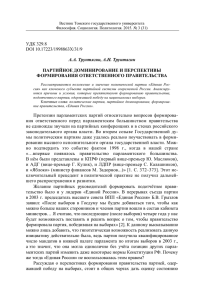
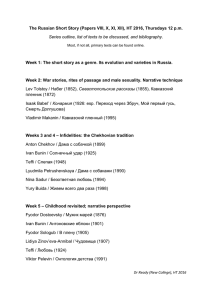
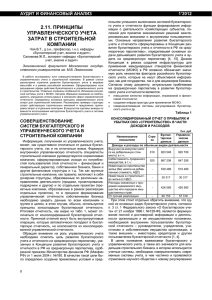

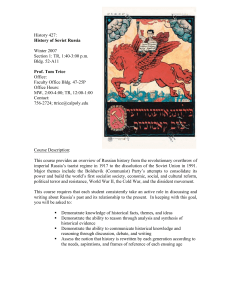
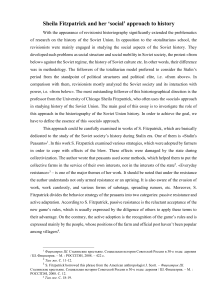
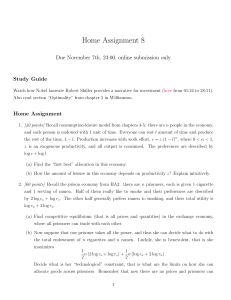
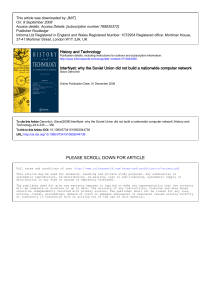
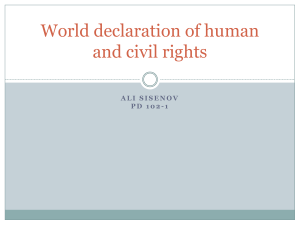
![[Amin Saikal] Modern Afghanistan A History of Str (2)](http://s1.studylib.ru/store/data/006271482_1-b711d605a48e19c1eb8ca65ce7b543af-300x300.png)